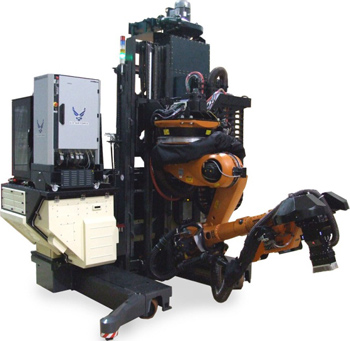Interesting Robotic Applications and Projects

Posted on May 15, 2014 in Robotics
4 min read time
In past blog posts we have talked about different categorized projects such as medical manufacturing, aerospace manufacturing, automotive manufacturing and general purpose robotic manufacturing. However, in our quest to find different robotic applications we often discard applications because they are not related to the main subject of the article or because we want to condense the article. This article is for all of those random applications that still remain interesting but… uncategorized!
Aircraft Maintenance: Paint Stripping
Paint or coating removal of any kind has always been a problem in terms of air pollution and human health. This robotic application can basically reduce or eliminate the noxious effect in coating removal. In fact, the Air Force Research Laboratory (AFRL) is currently developing and testing the Advanced Robotic Laser Coating Removal System (ARLCRS). The system consists of an advanced laser system (paired with a mobile robotic arm) that scans the aircraft body, removes the chemical coating and absorbs the particles that can eventually contaminate the air. The automated system is easily scalable, which means it can remove coating on small fighters, as well as on big cargo planes. The goal is basically to avoid environmental issues. In fact, the method is a lot more efficient than chemical stripping. So, at the end of the day, less chemicals are used, less protective equipment is required, no hazardous waste is emitted and no air pollution is created. This project also decreases the workload on aircraft maintenance personnel and can strip planes almost 24/7. The result is lower maintenance costs, a safer workplace, and a cleaner environment.

Soft robotics
As most or even all robots on the market are built from solid material, it is hard to figure out how a robot can be soft. Well, a lab at Harvard University has developed a soft gripper to push robot flexibility to the next level. In fact, the spider-like gripper was developed to mainly grab objects of different shapes and hardnesses, such as fruit or human organs. The other goal of the project was to get into uneven or unknown spaces by using a robot gripper that can theoretically make it’s way around anywhere. The end effector is built from a multi-chamber elastomer material and its motion is made by inflating and deflating the different chambers in a certain sequence. To feed the different chambers, a single source of pressure is needed. The air goes through a network called PneuNets, which has been designed by the team. This application could definitively change the medical world by introducing similar robot grippers into the body in order to carry out different operations in the body. Click here to get the complete paper on air powered, soft robot grippers.
Home 3D Printing
My mind has been blown by this product. In fact, although 3D printing has become more popular over the last couple of years, this product and all of its accessories, is taking 3D printing to the next level. This 3D printer from MakerBot is designed to fit on your desktop and be completely safe for everyone to use. The 3 axis robot uses a precise actuator and stepper motor to achieve the manufacturing precision of 100 microns. This means that most common objects can be modeled by this machine. This system can be used for fast prototyping, for industrial use, and at home for general purposes. At less than $3,000 this machine is now accessible. The coolest part, however, is clearly the accessories that can be added to this 3D printer. First of all, a camera is built into the printer frame and it can broadcast the manufacturing steps live to your phone. So if you need to go out between two parts you can see what is going on with the machine. The other cool aspect is the table digitizer that can connect to the 3D printer.
This device can digitize different objects and either print it or save it on your computer. It allows you to do reverse engineering or industrial spying… depending on your intention. The digitizer starts at $800 and can reach a detailed resolution of up to 0.5mm. The scanner can basically recreate the shape with as much as 200,000 triangles per part.
Ski tuning
For many years the technology behind ski tuning has always been advancing. In ski racing, when the difference between the winner and loser is only tenths of a second, your skis always have to be well tuned. This is why companies like Wintersteiger are developing completely automated ski tuning. The ski tuning process begins in the ski loader, where the machine can store up to sixteen skis. The skis are then loaded into the trimming line. In fact, the first step is to repair or reshape the structure of the skis into a given shape for optimal water evacuation. An infinite number of structures can be made by a single spinning rock. Then, the skis are sharpened in two different steps - first the bevel and then the side. Both operations are performed at a given angle for the convenience of the rider. Next, polishing is done to remove any burrs and finally waxing and polishing steps follow to make sure the skis are ready to hit the slopes. The skis are then stored in a ski loader. All of these operations are executed automatically and with a precise pressure to achieve a perfectly smooth and fast ski.

Take into consideration the new robotic and industrial automation examples mentioned in this article and think about new ways to automate your processes. A lot of improvements can be made in any given process, thus giving you better and more consistent results. Keep your eyes peeled for the next idea or application that you can get involved in.








Leave a comment